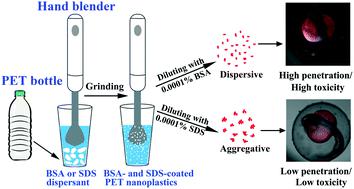当前位置:
X-MOL 学术
›
Environ. Sci.: Nano
›
论文详情
Our official English website, www.x-mol.net, welcomes your
feedback! (Note: you will need to create a separate account there.)
Realistic polyethylene terephthalate nanoplastics and the size- and surface coating-dependent toxicological impacts on zebrafish embryos
Environmental Science: Nano ( IF 5.8 ) Pub Date : 2020-07-08 , DOI: 10.1039/d0en00464b Yunxia Ji 1, 2, 3, 4, 5 , Chuyu Wang 1, 2, 3, 4, 5 , Yunqing Wang 1, 2, 3, 4, 5 , Longwen Fu 1, 2, 3, 4, 5 , Mingsan Man 1, 2, 3, 4, 5 , Lingxin Chen 1, 2, 3, 4, 5
Environmental Science: Nano ( IF 5.8 ) Pub Date : 2020-07-08 , DOI: 10.1039/d0en00464b Yunxia Ji 1, 2, 3, 4, 5 , Chuyu Wang 1, 2, 3, 4, 5 , Yunqing Wang 1, 2, 3, 4, 5 , Longwen Fu 1, 2, 3, 4, 5 , Mingsan Man 1, 2, 3, 4, 5 , Lingxin Chen 1, 2, 3, 4, 5
Affiliation

|
Nanoplastics (NPs) as pollutants in aquatic environments and as a public health issue due to their accumulation in food chains are of increasing concern. However, previous studies have employed mainly commercial, chemically synthesized polystyrene model particles. Commercial NPs made of polyethylene terephthalate (PET), which is widely used in drinking bottles and packaging, are rarely manufactured, and thus have not been frequently studied in the laboratory. This seriously limits our understanding of their real environmental and biological effects. Herein, we employ a simple method for producing PET NPs directly from plastic bottles, preserving the PET chemical properties, and mimicking the mechanical breakdown process of plastics in nature. Using developing zebrafish embryos as an animal model, we investigate the bioaccumulation and in vivo toxicity of the produced PET NPs, which have diameter sizes of 20, 60–80, and 800 nm and are capped by two dispersing agents, i.e., BSA and SDS. This study demonstrates the size-dependent distribution and the size- and concentration-dependent toxicity of PET NPs in terms of hatching rate, heart rate, and ROS generation. It also reveals that the PETBSA NP treatment groups exhibited higher-level abnormalities in heart rate and more severe oxidative damage than the PETSDS NP treatment groups. Taken together, this work proposes a novel mechanical preparation protocol for PET NPs and provides evidence relating to the toxicity of environmentally relevant NPs towards aquatic organisms.
中文翻译:

现实的聚对苯二甲酸乙二醇酯纳米塑料及其对斑马鱼胚胎的大小和表面涂层依赖性毒理学影响
纳米塑料(NPs)在水生环境中作为污染物,由于其在食物链中的积累而成为公共卫生问题,这一问题日益受到关注。但是,先前的研究主要采用了商业上化学合成的聚苯乙烯模型颗粒。由聚对苯二甲酸乙二酯(PET)制成的商用NPs广泛用于饮用瓶和包装,但很少生产,因此在实验室中并未进行频繁研究。这严重限制了我们对其真正的环境和生物影响的理解。在这里,我们采用一种简单的方法直接从塑料瓶生产PET NP,保留PET的化学性质,并模仿自然界中塑料的机械分解过程。使用发育中的斑马鱼胚胎作为动物模型,我们研究了生物积累和所产生的PET NP的体内毒性,其直径大小为20、60-80和800 nm,并且被两种分散剂(即BSA和SDS)封端。这项研究证明了在孵化率,心率和ROS产生方面,PET NP的大小依赖性分布以及大小和浓度依赖性毒性。这也表明,PET BSA NP治疗组比PET SDS NP治疗组表现出更高水平的心率异常和更严重的氧化损伤。综上所述,这项工作为PET NPs提出了一种新颖的机械制备方案,并提供了与环境相关的NPs对水生生物的毒性有关的证据。
更新日期:2020-08-14
中文翻译:

现实的聚对苯二甲酸乙二醇酯纳米塑料及其对斑马鱼胚胎的大小和表面涂层依赖性毒理学影响
纳米塑料(NPs)在水生环境中作为污染物,由于其在食物链中的积累而成为公共卫生问题,这一问题日益受到关注。但是,先前的研究主要采用了商业上化学合成的聚苯乙烯模型颗粒。由聚对苯二甲酸乙二酯(PET)制成的商用NPs广泛用于饮用瓶和包装,但很少生产,因此在实验室中并未进行频繁研究。这严重限制了我们对其真正的环境和生物影响的理解。在这里,我们采用一种简单的方法直接从塑料瓶生产PET NP,保留PET的化学性质,并模仿自然界中塑料的机械分解过程。使用发育中的斑马鱼胚胎作为动物模型,我们研究了生物积累和所产生的PET NP的体内毒性,其直径大小为20、60-80和800 nm,并且被两种分散剂(即BSA和SDS)封端。这项研究证明了在孵化率,心率和ROS产生方面,PET NP的大小依赖性分布以及大小和浓度依赖性毒性。这也表明,PET BSA NP治疗组比PET SDS NP治疗组表现出更高水平的心率异常和更严重的氧化损伤。综上所述,这项工作为PET NPs提出了一种新颖的机械制备方案,并提供了与环境相关的NPs对水生生物的毒性有关的证据。











































 京公网安备 11010802027423号
京公网安备 11010802027423号